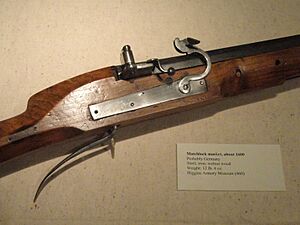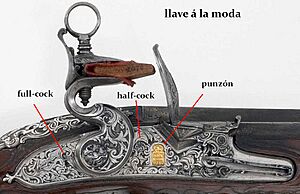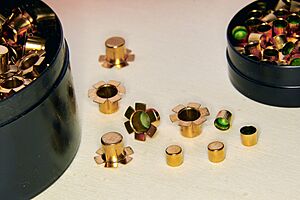Smoothbore facts for kids
A smoothbore weapon is a type of gun that has a barrel without any special grooves inside. These grooves are called rifling. Smoothbore weapons can be small, like handheld firearms, or very large, like powerful tank guns and big mortars used in artillery. Most shotguns are smoothbore weapons. Because of this, the words "shotgun" and "smoothbore" often mean the same thing.
Contents
The History of Smoothbore Weapons
The first time a smoothbore weapon was mentioned was around the year 1000 in a place called Dunhuang. This early weapon was known as a "fire lance." The main parts of any gun are its barrel, the powder that makes it fire, and the projectile (like a bullet or shot) that comes out. A gun also needs a way to light the powder. The very first guns were made from bamboo, but later they were made with metal barrels. The first guns made in large numbers were called matchlocks.
Matchlock Guns
The classic matchlock gun used in Europe was a smoothbore weapon. It had a burning slow match (a special rope that burns slowly) held in a clamp. This clamp was on a small curved arm called a "serpentine." When a soldier pulled this arm (or later, a trigger), the burning match would drop into a small pan called the "flash pan."
This action lit a small amount of powder in the flash pan. The flash from this powder then traveled through a tiny hole into the main part of the barrel, lighting the main powder charge. This made the gun fire.
One big problem with matchlocks was that the match had to be burning all the time. The match was often soaked in a chemical called potassium nitrate to help it burn longer. If the match wasn't lit when the gun was needed, the gun couldn't be fired. This was especially difficult in wet weather. Another issue was that the glowing match could be seen at night, showing where the soldier was hiding. The smell of the burning match cord also gave away their position. However, a major good point of the matchlock was that it let the shooter hold the gun up to their eye level to aim better.
Flintlock Guns
About 200 years after the matchlock, the next big step in gun design was the flintlock. This gun used a flint stone to create a spark. It also had a smaller "priming pan" instead of a flash pan. This pan held a small amount of powder and had an opening to light the main powder charge inside the barrel. A small piece of steel, called a "frizzen," was attached to the top of the priming pan.
When the trigger was pulled, the flint struck the frizzen. This created a spark that lit the powder in the priming pan. The fire then traveled into the barrel, igniting the main powder charge. To get the gun ready, the powder and a ball were loaded into the barrel and pushed down with a ramrod. The hammer was then pulled back to a "half-cocked" position. To make it ready to fire, the hammer was pulled back all the way to the "full-cocked" position. When the trigger was pulled, a spring made the hammer fall, causing the gun to fire. Flintlocks were the main type of firearm for the next 200 to 300 years. They were later replaced by guns that used percussion caps.
Percussion Cap Guns
The percussion cap system was the next big improvement for firearms. It was also called a caplock. This system came from the discovery of a chemical called fulminate of mercury around 1800. This chemical explodes when it is hit hard. In 1816, an artist named Joshua Shaw, who lived in Philadelphia, put fulminate of mercury inside small copper caps. He then placed these caps over a small part called a "nipple" on the gun's firing hole. When the hammer hit the percussion cap, the gun fired. By 1826, these caps were widely used and had taken the place of flintlocks.
The percussion cap system removed the need for the flash pan, flint, and frizzen. It did add the step of placing a cap on the nipple, but this was a great help to soldiers in battle. Percussion caps were fast to load and worked well in almost all weather conditions.
Smoothbore Cannons
Simple cannons existed in China from about the 12th century, or maybe even earlier. One of the first large weapons used in Europe was called a bombard. These were built with different sized barrels to fire anything from a small rock to a large cast iron ball. By the 16th century, cannons started to replace bombards. The way metal was cast improved a lot in Europe after about 1570.
In the early 1500s, French cannons were used to break up large groups of soldiers carrying pikes during their wars in Italy. The Germans had some of the best gunners in Europe. They created cannons that could hit targets up to 1,500 yards away. Later, the Swedish army, led by Gustavus Adolphus, developed light cannons. These cannons could be easily moved around the battlefield. He used a cast 4-pounder cannon that weighed about 4 pounds and could be pulled by just two horses.
In 1742, an Englishman named Benjamin Robins wrote a book called New Principles of Gunnery. In this book, he added science to the study of how bullets and shells fly, which is called ballistics. He developed carronades, which were short, light smoothbore cannons. These were often used on the decks of ships. During the American Revolutionary War, the British army had many different cannons and mortars. Many of the American weapons were actually British cannons that had been captured.
In 1853, France introduced the Canon-obusier de 12. This was a 12-pounder cannon that could fire both solid cannonballs and explosive shells. The U.S. Army adopted a similar gun, the Napoleon 12-pounder, in 1857. It became the most popular field gun for both sides during the American Civil War. Eventually, these smoothbore cannons were replaced by cannons with rifled barrels after the Civil War.
Images for kids
-
Aston-Johnson 54 caliber smoothbore pistol
-
Replica of "Twin Sisters" smoothbores used in the Battle of San Jacinto (1836)
-
USS Monitor (1862) with the muzzle of one of its two 11-inch smoothbore Dahlgren guns showing
See also
 In Spanish: Ánima lisa para niños
In Spanish: Ánima lisa para niños










